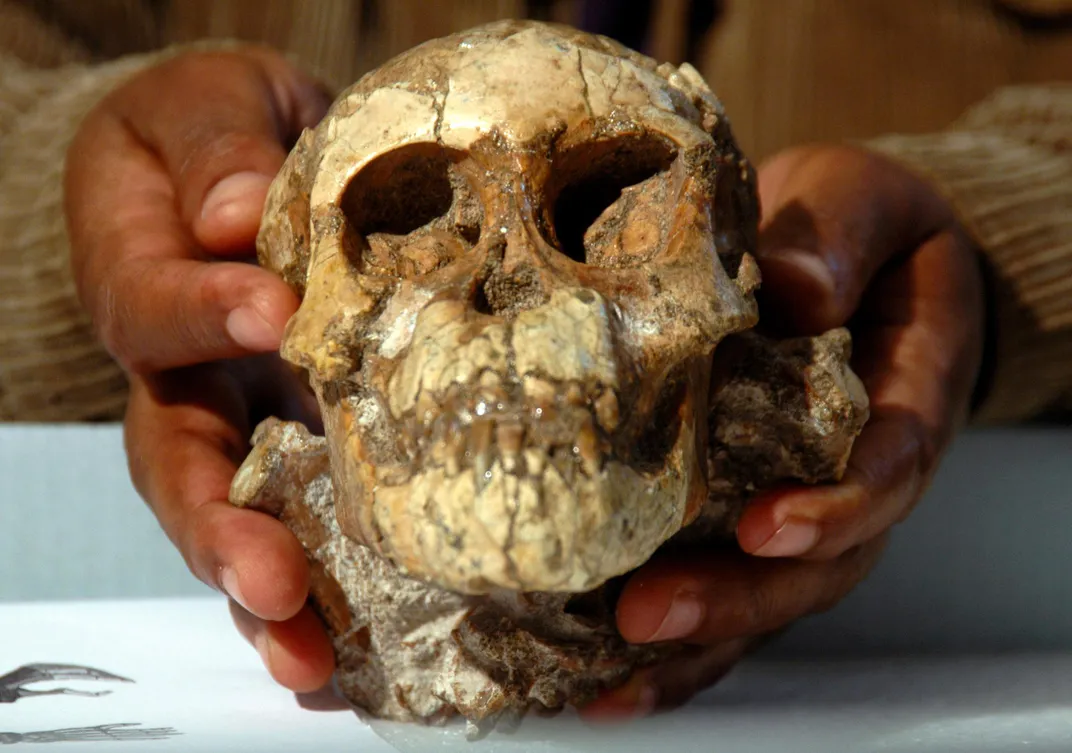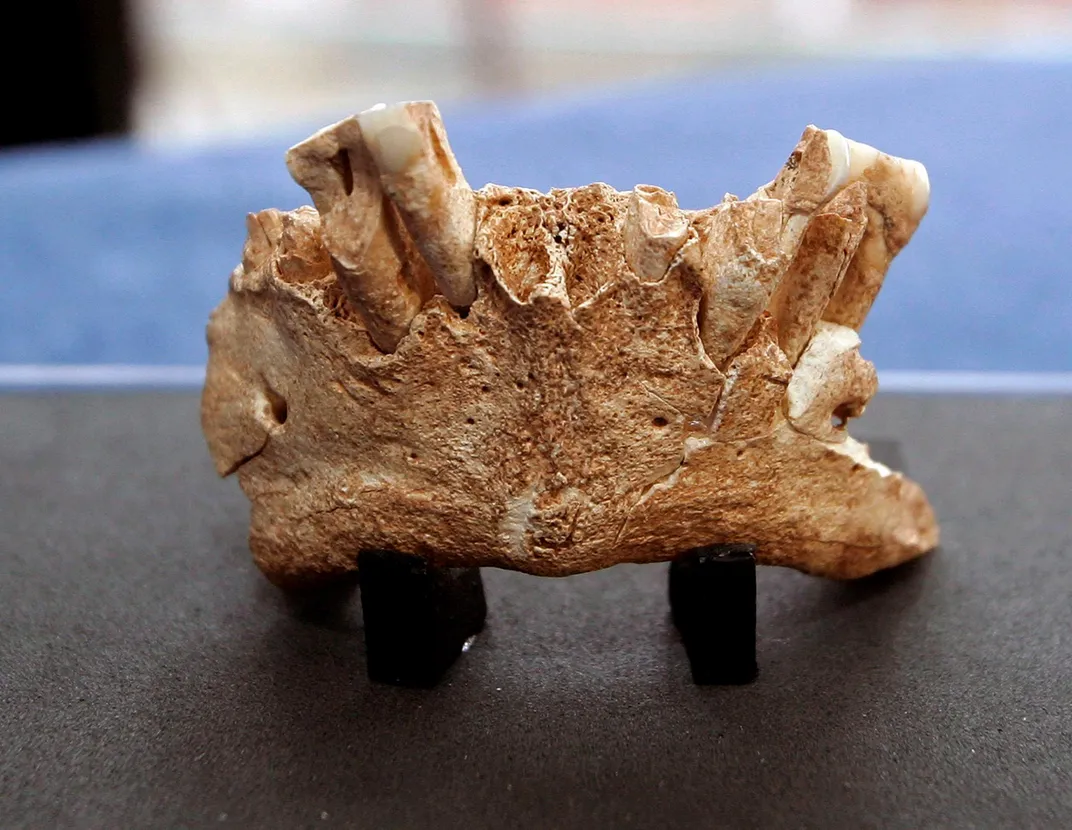How Climate Change May Have Shaped Human Evolution
Evidence is building that past climate change may have forged some of the defining traits of humanity
/https://tf-cmsv2-smithsonianmag-media.s3.amazonaws.com/filer/ad/d2/add25abe-a204-4b29-862c-23ef28698415/42-16483732.jpg)
Earth's climate has always been in a state of flux. Ever since our ancestors branched off the primate evolutionary tree millions of years ago, the planet has faced drastic swings between moist and dry periods, as well as long-lived glacial freezes and thaws. It's clear that early humans were able to survive such changes—our existence confirms their success. But a growing number of scientists think that major climate shifts may have also forged some of the defining traits of humanity.
In particular, a few large evolutionary leaps, such as bigger brains and complex tool use, seem to coincide with significant climate change. “I think, to be fair, all we have at the moment is coincidence,” said Peter B. deMenocal of Columbia University's Lamont-Doherty Earth Observatory. But he and other researchers are exploring several lines of evidence, from ancient teeth to seafloor sediments, to see if a more concrete link can be supported.
The data is also helping scientists sift through the possible theories for just how climate might have triggered evolutionary advances. For instance, one idea is that big leaps forward were not driven by adaptation to a specific habitat change, but by a series of frequent changes. In other words, humans evolved to live with uncertainty. Rick Potts at the Smithsonian Institution's Human Origins Program calls this idea “variability selection”, and it’s possible at least two major evolutionary events can be linked to periods of climate instability.
“Roughly between 3 and 2.5 million years ago, the lineage of ‘Lucy’ [Australopithecus afarensis] became extinct and the first members of our own genus, Homo, appeared. The first simple stone tools also appeared with those fossils, which featured some modern traits like bigger brains,” deMenocal says. “Then, between 2 million and 1.5 million years ago, we see Homo erectus.” That bigger-brained hominin had a skeleton very much like our own, more sophisticated tools like double-bladed axes and new behaviors that led early humans out of Africa for the first time.

Both of these events happened at times when the local climate was undergoing dramatic shifts. We know, for instance, that some 3 million years ago—around the time the first Homo species appeared—Africa was switching from wooded areas to open grasslands as the climate dried out. This straightforward change in scenery may be part of why early humans evolved away from climbing and toward walking upright. But recent evidence collected from the seafloor gives an even more detailed look at the climate change during this period.
For his work, deMenocal drills into the seafloor along Africa's coasts, where sediments that would have been long since dispersed on land remain in orderly tiers. Sediments blown offshore from Africa and Arabia have accumulated here at a rate of some 1.5 inches per 1,000 years, creating a climatic layer cake of alternating light and dark bands. During dryer periods, layers feature the dark, gritty dirt blown out to sea by ancient monsoons. During wet periods, the layers contain light amalgamations of abundant fossilized plankton.
The cores reveal swings between very wet and very dry periods about every 20,000 years. This follows a regular cycle, governed by a wobble in Earth's orbit, that increases and decreases the amount of available sunlight hitting the planet. These periods of oscillation happened very rapidly on geologic time scales. Intriguingly, the most pronounced fluctuations happened 3 to 2.5 million years ago, and again a million years later—during the two major periods of early human advancement.
Further evidence of this unstable ancient world can be found in modern Africa. The Great Rift Valley is home to many of the most important fossils in early hominin evolution, so Mark Maslin, a geographer at University College London, studied the valley's paleoclimate record. His team found that lake basins there were very sensitive to the same rapid changes in climate approximately 2.5 million years ago, and at 1.7 million years ago. “These freshwater lakes can fill up or disappear with changes in rainfall,” he says. “We found that these particular periods, or ‘pulses’, when the lakes come and go correlate directly with major changes in human evolution. The two records are absolutely compatible.”
Fossil tooth analysis, rich in carbon isotopic data, helps to further flesh out what our ancestors were eating and drinking during these volatile periods, and what types of environments they called home. These studies show Homo bucking a trend in which earlier peoples passively fed on the expanding grasslands, says deMenocal. This indicates that more successful early humans sought diverse food options during variable periods even as the African landscape was, in the long term, trending toward a more uniform grassland environment.
“Around 2 million years ago, looking at the teeth of Homo, you see a diet that's nearly 50-50 split between grasses and other foods,” says deMenocal. “So there is increasing geochemical evidence for changes in diet that indicate great flexibility including carcass processing, large migrations and behavioral changes that really seem to indicate a different mode of living.” Homo bestowed these valuable traits on future lineages while contemporary species with a more limited diet died out.

But just identifying a possible relationship between shifting climate and evolutionary leaps doesn’t help scientists figure out exactly what triggered a particular advance, Maslin says.
“My thinking is that there are lots of intriguing theories of human evolution, but each could actually be right,” he says. “So you could pick any period in this changing landscape and it may have affected a different trait.” For example, it's plausible to theorize that our ancestors’ brains might have expanded when the lakes were highly variable, because hominins had to become smarter to determine where their next meals would come from, Maslin says.
“On the other hand, it could be that in wet periods, when there are lots of resources, sexual selection kicks in and the most clever females are saying, Whichever of the males is controlling the group, I'm having him as a partner.” Studies of later periods such as the Middle Stone Age (about 80,000 to 40,000 years ago) link rapid climate change that created wet conditions in South Africa to innovations in language and cultural identity, including symbolic engravings and shell jewelry.
And the rise of agriculture roughly 10,000 years ago coincides with shifting climates after the end of the last glaciation. Some scientists have theorized that the retreating ice made it easier, or perhaps even necessary, for humans to domesticate plants in the Near East. But some mixed signals exist as well. Later expansions of the early human brain—smaller but still significant leaps—appear to have occurred during periods of relatively stable climate, Maslin says.
Other researchers suggest that ancient climate change acted on humans in a way more akin to evolutionary adaptations seen in other animals and plants. John Stewart of Bournemouth University thinks that shifting climate likely moved people around the landscape of what is now Europe and Asia, isolating some populations and creating conditions that can lead to evolutionary shifts and the rise of new species.
Studies have shown that past ice ages may have forced species such as the hedgehog into smaller areas, or refugia, where they could survive. Those species were not genetically the same when they emerged and expanded as their preferred climate returned. If these processes acted the same way on hominins, Neanderthals and Denisovans may have arisen from early groups such as Homo heidelbergensis, when they became isolated in small, livable pockets of the frigid Northern Hemisphere.
“We've looked at other organisms and how they adapted during the last few interglacial cycles,” Stewart says, referring to work done with Chris Stringer of the Natural History Museum, London. “Some patterns seem to occur when you look at geographic spread and genetics, and we looked at humans in that same light. If we believe in organic evolution, we shouldn't invent new processes for humans or treat them as a special case. We should fit them into this larger picture.”
The process might not work the same way in locations closer to the Equator, where climate change was perhaps not as extreme, Stewart adds. And he believes that his theory isn't mutually exclusive with the type of variability selection that Rick Potts, Peter deMenocal and others espouse.
“But I do think, to me, variability selection isn't a mechanism to make a new species. It's more of a mechanism to make a successful lineage that can spread and allow it to cope with lots of different scenarios,” says Stewart. “To make two species out of one, I think you need that kind of geographic isolation that was driven by climate.” Still, he says, “there's no doubt about it—humans are able to cope with lots of different things, and something in evolution must have made that so.”